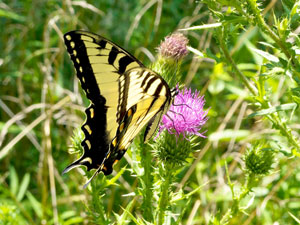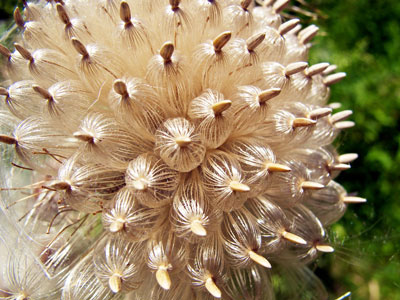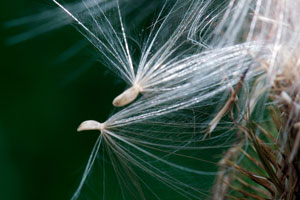
By Ken Moore
Flora Columnist
Durham resident Parker Chesson recently captured the above image of a swallowtail on a bull thistle flower head. Parker continued his “closer look†and then captured (see back-page photo) the pre-expulsion stage of a mature seed head, which is every bit as beautiful as the flower itself. I’ve observed bull thistle seed heads countless times without ever catching this particular moment in time.
Bull thistle, Cirsium vulgare, more commonly called spear thistle in Great Britain, is an alien plant on our turf. Needle-sharp spines cover the entire plant; farmers and horse owners curse it in their fields. It’s listed as a “plant to avoid†on the N.C. Botanical Garden’s website, and the N.C. Native Plant Society (ncwildflower.org) includes it on their Rank 3 list of unwanted invasives.
It can be easily spotted in small populations on disturbed ground and along roadsides. The peak of thistle flowering has passed, though you will likely spot a few still flowering here and there. Most notable just now are the silky plumed seeds soaring aloft on summer breezes. It may be a surprise that those bits of flying silk come from that brilliant-purple thistle head. Thistle flower heads are visited by several butterfly species and other colorful winged pollinators partaking in what must be a nectar feast. I was fortunate to have a seldom-seen zebra swallowtail visit one of the volunteer plants in my yard last week.
The purple flower head, another example of the aster (composite) family’s compact head of disc or tube flowers, is mature for only a single day. Almost overnight, that needle-barbed flower head changes to a ball of silky fluff ready to take flight. It’s fun to watch goldfinches brave the spiny heads to eat the ripe seeds. I believe those goldfinches are pretty efficient in harvesting the ripe seed – because every time I pluck one of those flying seed plumes from the air, I find the seed missing. So perhaps the birds are helping keep this exotic in check.
For several years, armed with sturdy gloves, I enjoyed taking a stem or two of the thistle flowers to an old friend of Scottish heritage. Even with gloves, I found the experience painfully prickly.
It’s easy to accept the stories that the early Scots adopted the spear thistle as their national emblem because of the numerous tales of invaders running into fields of thistles and crying out in pain, thus alerting the defending Scots. Though historians still debate which particular thistle is the official Scottish Thistle, most have settled on this one.
Rather hard to believe are the various accounts of the edible and medicinal qualities of this otherwise untouchable weed. Space doesn’t allow for them here, but for those of you interested, go to Jim Duke’s Handbook of Edible Weeds and Tom Brown Jr.’s Tom Brown’s Field Guide: Wild Edible and Medicinal Plants for downright mouthwatering descriptions of harvesting and preparing spear thistle roots, stems, leaves and flower heads.
So next time you’re out and about, tread softly among the Cirsium vulgare as you share what you know with your walking companion!
Email Ken Moore at flora@carrborocitizen.com.
Find previous Ken Moore Citizen columns at The Annotated Flora.



Wow, Parker! that photo of the seeds taking flight is fantastic!
Warmly,
Brian